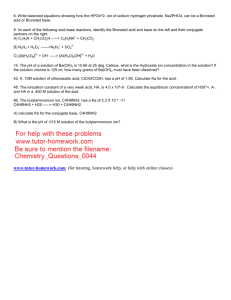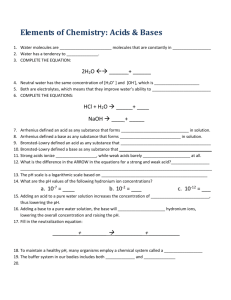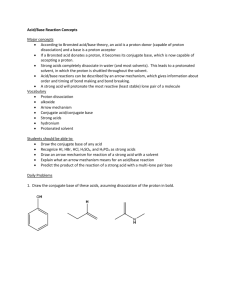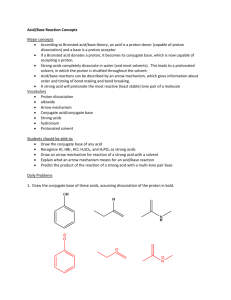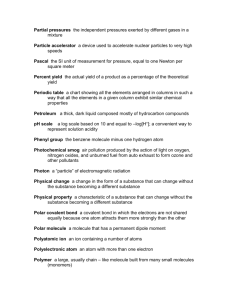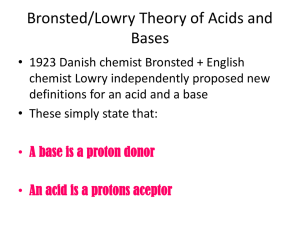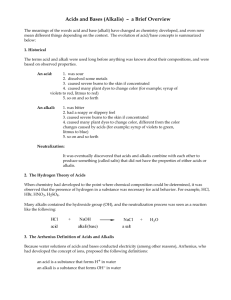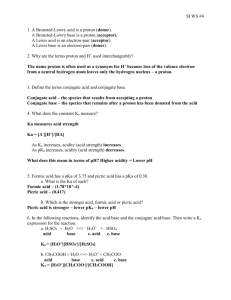Chapter 14, Section 2/Section 3 Acids and Bases
advertisement
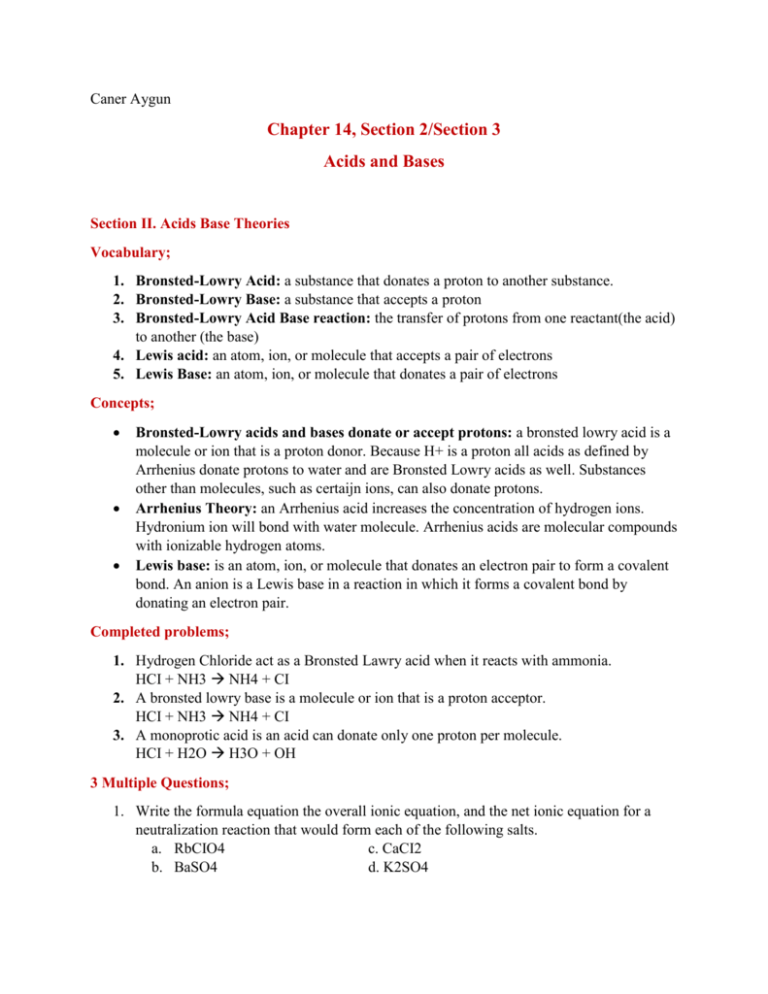
Caner Aygun Chapter 14, Section 2/Section 3 Acids and Bases Section II. Acids Base Theories Vocabulary; 1. Bronsted-Lowry Acid: a substance that donates a proton to another substance. 2. Bronsted-Lowry Base: a substance that accepts a proton 3. Bronsted-Lowry Acid Base reaction: the transfer of protons from one reactant(the acid) to another (the base) 4. Lewis acid: an atom, ion, or molecule that accepts a pair of electrons 5. Lewis Base: an atom, ion, or molecule that donates a pair of electrons Concepts; Bronsted-Lowry acids and bases donate or accept protons: a bronsted lowry acid is a molecule or ion that is a proton donor. Because H+ is a proton all acids as defined by Arrhenius donate protons to water and are Bronsted Lowry acids as well. Substances other than molecules, such as certaijn ions, can also donate protons. Arrhenius Theory: an Arrhenius acid increases the concentration of hydrogen ions. Hydronium ion will bond with water molecule. Arrhenius acids are molecular compounds with ionizable hydrogen atoms. Lewis base: is an atom, ion, or molecule that donates an electron pair to form a covalent bond. An anion is a Lewis base in a reaction in which it forms a covalent bond by donating an electron pair. Completed problems; 1. Hydrogen Chloride act as a Bronsted Lawry acid when it reacts with ammonia. HCI + NH3 NH4 + CI 2. A bronsted lowry base is a molecule or ion that is a proton acceptor. HCI + NH3 NH4 + CI 3. A monoprotic acid is an acid can donate only one proton per molecule. HCI + H2O H3O + OH 3 Multiple Questions; 1. Write the formula equation the overall ionic equation, and the net ionic equation for a neutralization reaction that would form each of the following salts. a. RbCIO4 c. CaCI2 b. BaSO4 d. K2SO4 2. Which of the following is a Bronsted Lowry base? a. An electron pair donor b. An electron pair acceptor c. A proton donor d. A proton acceptor 3. Which acid is the most commonly produced industrial chemical? a. Hydrochloric acid b. Acetic acid c. Nitric acid d. Sulfuric acid Calculation Problems; 1. Label each reactant in the reaction below as a proton donor or a proton acceptor and as acidic or basic. H2CO3 + H2O HCO3 + H3O 2. For the reaction below label each reactant as an electron pair acceptor or electron pair donor and as a Lewis base. ALCI3 + CI ALCI4 Section 3 – Acid – Base Reactions Vocabulary; 1. Conjugate base: a base that forms when an acid loses a proton 2. Conjugate acid: an acid that forms when a base gains a proton 3. Amphoteric: describes a substance, such as water, that has the properties of an acid and the properties of a base 4. Neutralization: the reaction of the ions that characterize acids and the ions that characterize bases to form water molecules and a salt 5. Salt: an ionic compound that forms when a metal atom or a positive radical replaces the hydrogen of an acid 3 concepts; 1. Bronsted Lowry reactions involve conjugate acid-base pairs: the bronsted lowry of acids and bases provide a basis for studying proton transfer reactions. The species that remains after a bronsted lowry acid has given up a proton is the conjugate base of that acid. 2. Using strength to predict reactions: this concept allows strength of different acids and bases to be compared to predict the outcome of a reaction. 3. Strong acid-base neutralization: an acid base reaction occurs in aqueous solution between hydrochloric acis’ a strong acid that completely ionizes to produce H3O and sodium hydroxide. Multiple choices; 1. Which of the ollowing is a conjugate pair? a. H+ and OH b. NH2 and NH4 c. HCI and CI d. H2SO4 and SO422. Which of the fllowing species is the conjugate acid of another species in the list? a. PO43b. H3PO4 c. H2O d. H2PO43. Identify the salt that forms when a solution of H2SO4 is titrated with a solution of Ca(OH)2 a. Calcium sulfate b. Calcium hydroxide c. Calcium oxide d. Calcium phosphate Calculation Problems; 1. How does a strong acid differ from weak acid? Give one example of each. 2. Write the full equation, ionic equation, and net ionic equation for the neutralization reaction between ammonia and sulfuric acid. Identify the spectator ion(s).
